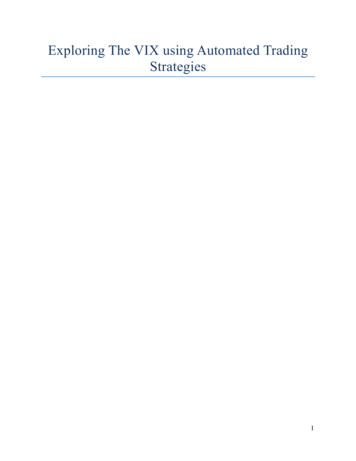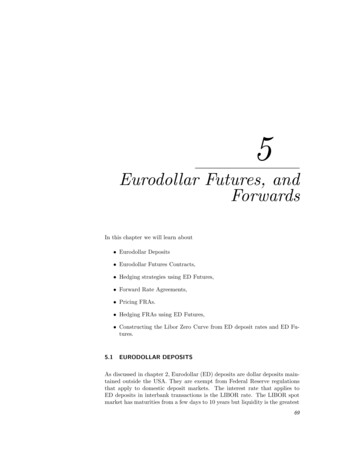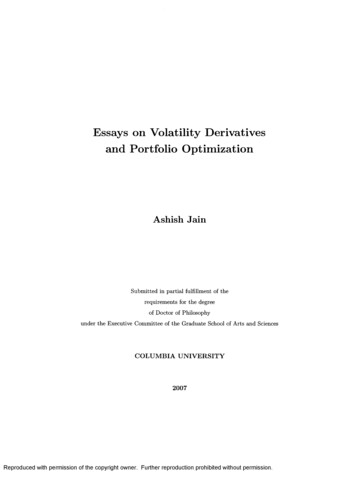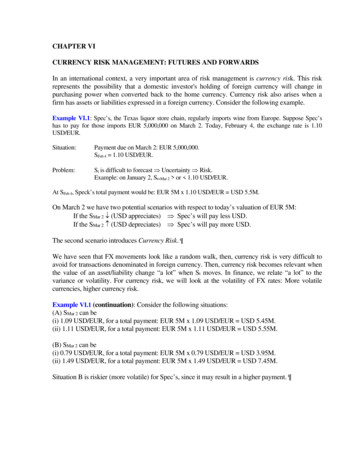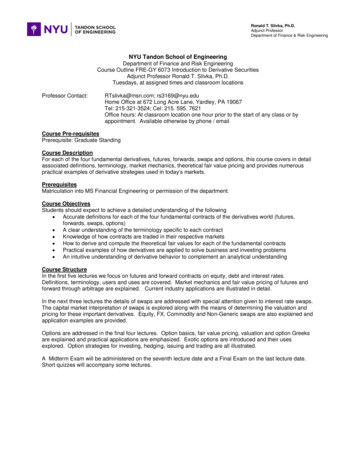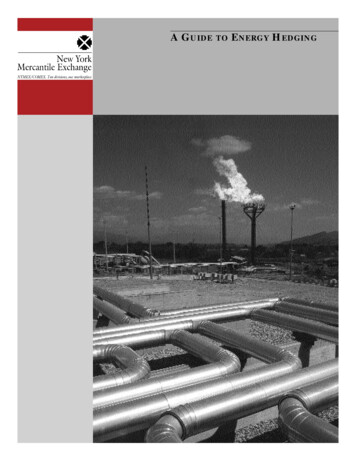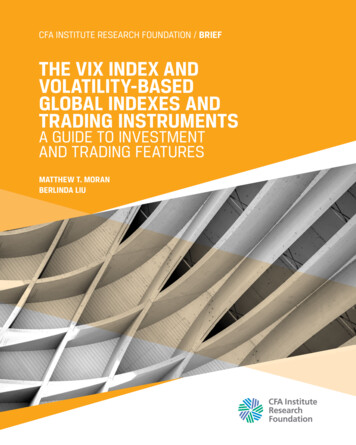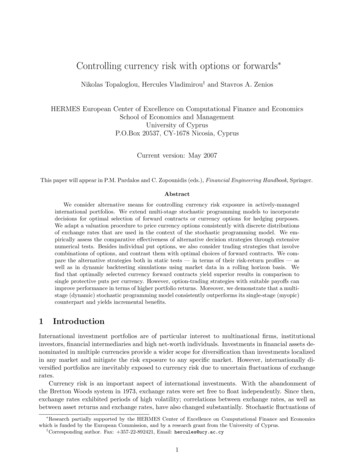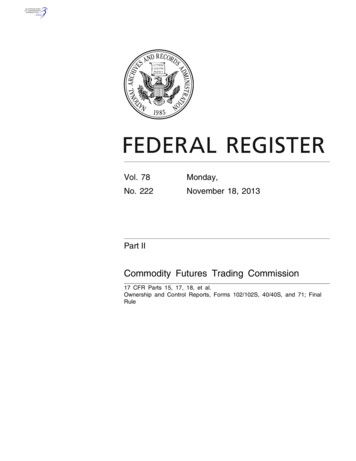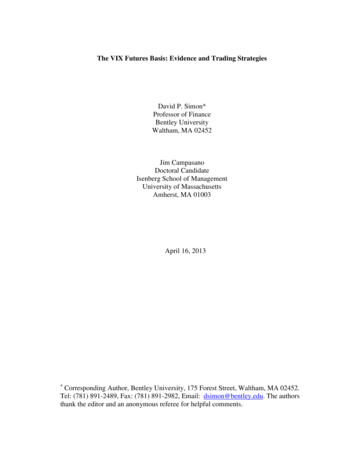
Transcription
The VIX Futures Basis: Evidence and Trading StrategiesDavid P. Simon*Professor of FinanceBentley UniversityWaltham, MA 02452Jim CampasanoDoctoral CandidateIsenberg School of ManagementUniversity of MassachusettsAmherst, MA 01003April 16, 2013 Corresponding Author, Bentley University, 175 Forest Street, Waltham, MA 02452.Tel: (781) 891-2489, Fax: (781) 891-2982, Email: dsimon@bentley.edu. The authorsthank the editor and an anonymous referee for helpful comments.
The VIX Futures Basis: Evidence and Trading StrategiesAbstractThis study demonstrates that the VIX futures basis does not have significant forecastpower for the change in the spot VIX from 2006 through 2011 but does have forecastpower for VIX futures price changes. The study then demonstrates the profitability ofshorting VIX futures contracts when the basis is in contango and buying VIX futurescontracts when the basis is in backwardation with the market exposure of thesepositions hedged with mini-S&P 500 futures positions. The results indicate that thesetrading strategies are highly profitable and robust to transaction costs and out ofsample hedge ratio forecasts. Overall, the analysis supports the view that the VIXfutures basis does not accurately reflect the mean-reverting properties of the VIX spotindex but rather reflects a risk premium that can be harvested.2
The VIX Futures Basis: Evidence and Trading StrategiesVolatility has become a widely accepted asset class since the introduction of the VIXfutures contract in 2004. The popularity of the VIX futures contract stems from its hedgingproperties, which owe to its reliably negative correlation with equity returns and its usefulness asinsurance against tail risk.1 Szado (2010) and Alexander and Korovilas (2011) examine the impactof adding long VIX futures positions to equity portfolios and find that while long VIX futurespositions are drags on equity portfolio returns during calm periods, they provide substantialbenefits during steep equity market selloffs. Much of the losses on long VIX futures positionsduring calm periods result from VIX futures rolling down a typically upward sloped futures curve.This phenomenon suggests the profitability of short VIX futures positions when the VIX curve isupward sloped.Other studies, such as Zhang and Zhu (2006), Zhang et al. (2010) and Dupoyet et al.(2011), focus on modeling the VIX futures curve. These studies assume that volatility follows amean reverting process, which implies that the basis reflects the risk-neutral expected path ofvolatility.2 Accordingly, when the VIX futures curve is upward sloped (in contango), the VIX isexpected to rise because it is low relative to long run levels, as reflected by higher VIX futuresprices.3 Likewise, when the VIX futures curve is inverted (in backwardation), the VIX is expectedto fall because it is above its long run levels, as reflected by lower VIX futures prices. Thus,1Tail risk hedging refers to hedging against extreme adverse market moves and was championed by Taleb (2007), whoclaims that such events are far more frequent than market participants generally believe. Tail risk insurance becameextremely popular in the aftermath of the large equity market declines associated with the financial panic that began in2008.2Because the VIX index is not readily tradable, the basis is not determined by cash and carry and reverse cash and carryarbitrage as is typically the case for most financial futures contracts.3For expositional ease this study refers to the VIX spot price as the VIX and the relationship between VIX futures pricesand the VIX as the VIX futures curve. This study also describes VIX futures trading above the VIX as contango or anupward sloped VIX futures curve and VIX futures trading below the VIX as backwardation or an inverted VIX futurescurve.
contango and backwardation reflect risk-neutral expected VIX increases and decreases,respectively, and the steepness of the curve in either case reflects the speed of mean-reversion.The recent empirical evidence on the forecast power of models calibrated to the VIX futures curveindicates satisfactory out of sample forecast power for the one-day ahead VIX futures curve.Research that examines the forecast power of the VIX futures basis for future VIX pricesin a regression framework, such as Mixon (2007) and Nossman and Wilhelmsson (2009), indicatesinsignificant forecast power unless the basis is adjusted for a time-varying volatility risk premium.This risk premium owes to the usefulness of long VIX futures positions as hedges for equitypositions, which causes the basis to be more upward sloped than rational expectations woulddictate.This study examines trading opportunities presented by the VIX futures curve’s lack offorecast power for the subsequent VIX change. The study first assesses the forecast power of theVIX futures basis from 2006 through 2011 and finds consistent with previous studies that the basisdoes not have predictive power for VIX changes. This lack of forecast power suggests that theVIX futures basis forecasts VIX futures returns, which is confirmed.4 This finding is similar tothose of Erb and Harvey (2006) and Gorton and Rouwenhorst (2006), who demonstrate moregenerally that the basis has profound effects on commodity futures index returns. These authorsshow that when futures markets are in backwardation, investors benefit from buying futurescontracts at discounts to spot prices given that backwardated markets are not associated withcommodity spot prices falling.5 Likewise, an implication of this finding is that when the curve is4For example, if the front futures contract is trading well above the spot price and the spot price at the settlement of thefutures contract is expected to be unchanged because the basis has no forecast power, the futures price must converge tothe expected unchanged spot price at the settlement of the futures contract and hence would tend to fall on average.Whether the tendency of futures prices to decline under these circumstances is statistically significant is another issue.5A parallel literature exists in the foreign currency literature where this phenomenon is referred to as the carry trade (seeDarvas (2009) and Burnside et al. (2011)). The trade involves borrowing in a low yielding currency and lending in a highyielding currency without hedging foreign currency risk in order to take advantage of the yield differential in light of thetendency of the higher yielding currency not to depreciate. This strategy is also similar to riding the yield curve in bond2
in contango, short futures positions benefit from selling futures contracts at premiums to spotprices. Of course, futures positions that benefit from the roll are exposed to risks associated withthe level of the futures curve. Similarly, VIX futures positions that take advantage of the basis orthe roll have similar risks associated with the VIX futures curve rising or falling. However, thepresent study shows that much of this risk is associated with equity prices rising or falling owing tothe strong tendency of the VIX to move inversely to equity returns, and as a result can be hedged.This study demonstrates that selling (buying) VIX futures contracts when the basis is incontango (backwardation) by more than a given threshold and hedging market exposure with short(long) S&P futures positions offers very attractive risk adjusted profits over the sample periodfrom January 2007 through the end of December 2011. The results are robust to conservativeassumptions about transaction costs, the use of out of sample forecasts to set up hedge ratios and tosplitting the sample period in half. The study proceeds as follows: the first section providesbackground information on VIX futures contracts and presents preliminary information about thedata. The second section focuses on tests of the forecast power of the VIX futures basis for bothVIX changes and VIX futures price changes. The third section simulates trading strategies and thefourth section discusses the implications of the findings.I. Background on the VIX Futures ContractThe Chicago Board Options Exchange (CBOE) introduced the Volatility Index (VIX) in1993 to provide a measure of the implied volatility of 30-day, at the money S&P 100 indexoptions. The current methodology for calculating the VIX was introduced in 2003 and is based onmarkets, where in a steep yield curve environment investors who buy longer duration bonds benefit from the relativelyhigher yield, which is not systematically offset by capital losses because steep yield curves are not associatedsystematically with rising interest rates.3
more heavily traded S&P 500 index options and provides a measure of 30-day implied volatility ina model-free framework consistent with the pricing of volatility swaps. The VIX is interpolatedfrom the mid-points of the bid-ask spreads of the two front month option contracts until the frontcontract has eight days until expiration, at which time options from the second and third contractsare used. The VIX is calculated as a weighted average of the prices of options that are out of themoney relative to the forward value of the S&P 500 index and have bid quotes above zero. Whilethe VIX is a useful indicator of the changing demand for the limited risk associated with beinglong S&P 500 index call options or hedging long stock portfolios with S&P 500 index put options,the VIX is not readily tradable. This is because while the VIX theoretically could be replicated bya basket of options, doing so would be prohibitively expensive because of the large number ofoptions that would have to be bought and traded on an ongoing basis to maintain the 30-dayinterpolated maturity of the VIX.The CBOE introduced VIX futures contracts in March 2004 to facilitate volatility tradingand to encourage investors to use volatility to hedge equity portfolios owing to the strong negativecorrelation between equity returns and implied volatility. 6 Another motivation was to give marketparticipants a pure way to trade implied volatility, which is far more complicated to do with S&Pindex options.7In light of the popularity of VIX futures contracts, the CBOE introduced VIXoptions in 2006 and Barclays introduced the first volatility exchange traded note (ticker symbol—6For example, Akoundi and Haugh (2010) show that the correlation between US large cap stocks and the VIX was -.65with monthly data from March 2006 through April 2010.7While market participants can bet on implied volatility rising by buying S&P 500 index straddles, these positions arenot pure bets on implied volatility because of exposure to other factors such as gamma and time decay. Also, if a straddlegoes well in or out of the money or as time elapses, the exposure of straddles to implied volatility changes (vega) can falldramatically. By contrast, the VIX futures contract is designed so that a one percentage point implied volatility changeis always worth 1,000. Nevertheless, the VIX futures curve should be consistent with the term structure of S&P 500index options and potential trading opportunities between S&P index options and VIX futures contracts is an interestingtopic for future research.4
VXX) in January 2009, in light of expected strong retail investor demand for a volatilityinstrument.8The data examined in this study are from January 2006 through the end of December2011. The sample period begins in January 2006 because of gaps in VIX futures trading activityprior to then. The study focuses on the front two VIX futures contracts because liquidity falls offand quoted bid-ask spreads rise substantially beyond the front two contracts. Because this studyexamines trading strategies, making sure that transaction costs associated with bid-ask spreads arereflected accurately and that the data are synchronous is extremely important. The VIX futuresdata used in this study are from CQG Market Data and include all bid and ask quotes, trades andsizes of each throughout the trading day. The closing VIX futures quotes used in this study areconstructed from what appeared on trading screens from 3:00 to 3:15 pm (CST) and specificallyare the first quote during this time interval with a bid-ask spread no greater than .10 VIX futurespoint or 100, as one VIX futures point is worth 1,000.9 In the absence of such a quote, the finalbid and ask quotes of the day are used. This procedure is consistent with the assumption madelater that trades are executed and full bid-ask spreads are paid at the first opportunity after 3:00 pmCST when bid-ask spreads are no more than .10 futures point, or in the absence of suchopportunities at the reported bid-ask spreads at the close.10 The VIX (spot index values) and thefront rollover adjusted mini-S&P 500 futures prices are taken from Pi Trading, which provides8The VXX provides exposure to a combination of the two front VIX futures contracts with a portion of the exposure to thefront contract rolled to the second contract each day to keep the average time until settlement of the VXX equal to onemonth. When the VIX futures curve is in contango, this roll can produce a significant headwind and not surprisingly, theVXX has attracted its share of negative publicity. From its launch through the end of the first quarter of 2012, the VXXlost 95 percent of its value owing to losses from contango and because the VXX was launched when implied volatility wasextremely high.9Regular trading hours for the VIX futures contract are from 8:30 AM to 3:15 PM CST, while extended hours tradingbegins at 7:00 AM CST.10As can be seen in exhibit 1, bid-ask spreads over the sample period are typically around .06 futures point. We originallyused closing data from Bloomberg but found that the closing bid-ask spreads occasionally were very wide, despite CQGdata showing a lot of activity with fairly tight bid-ask spreads in the last minutes of the trading day. The sometimes widebid-ask spread closing quotes recorded by Bloomberg likely reflects traders occasionally pulling their quotes at the veryend of the trading day.5
one-minute open, high, low, and close data during the trading day. The spot VIX values and themini-S&P 500 futures prices used in the study are averages of the open and closing quotes duringthe minute in which the above conditions for VIX futures contracts hold.11Exhibit 1 provides a statistical summary of the data examined in this study, including theVIX, the mid-point and bid-ask spread of the front two VIX futures contracts, the basis of the twoVIX futures contracts, defined as the levels of each of the front two VIX futures contract pricesminus the VIX, and the price of the front mini-S&P 500 futures contract. The exhibit shows thelevels and daily first differences of these variables (percent change in the case of the S&P 500futures contract) and for each provides the mean, standard deviation, maximum and minimumvalues, cutoffs for the top and bottom deciles, as well as skewness and kurtosis coefficients.The VIX averages 23.70 percent over the sample period from 2006 through 2011, whilethe means of the two front VIX futures contracts are higher at 23.84 and 24.36 percent. The peakand trough of the VIX are 81.11 and 9.88 percent. Not surprisingly, the range of VIX futuresprices is compressed relative to that of the VIX, consistent with a tendency of VIX futures pricesto be lower than the VIX when the VIX is at extremely high levels and above the VIX when theVIX is at extremely low levels. For example, the peak and trough prices of the front VIX futurescontract are 69.04 and 10.30 percent, respectively. The basis of the front VIX futures contractaverages 14 basis points with the cutoffs for the top and bottom deciles at 201 and -140 basispoints, respectively. The basis of the second VIX futures contract averages 66 basis points withcutoffs for the top and bottom deciles at 420 and -276 basis points, respectively. Thus, the VIXterm structure varies substantially over the sample period, despite the fact that on average it isupward sloping. Bid-ask spreads at the close average .062 and .068 futures points for the front and11For example, if the first bid-ask spread less than or equal to 10 cents occurs for the front VIX futures at 3:07 pm CST ona given day, the bid and ask of the VIX futures price is matched with the average of the open and close of both the spotVIX and the mini-S&P 500 futures price at 3:07 pm CST. Thus, the VIX futures basis is measured synchronously, as arethe prices of mini-S&P 500 futures contracts that are used to hedge VIX futures positions.6
second futures contract, although there are instances when bid-ask spreads at the close are verywide with the maximum values at roughly a full point for both contracts. Nevertheless, the cutofffor the top decile of bid-ask spreads is .10 futures point. VIX changes are more volatile than VIXfutures price changes with a standard deviation of 2.24 percentage points for the VIX versus 1.49and .99 for the front and second VIX futures contract. These standard deviations are associatedwith occasionally very large changes in the VIX and VIX futures prices—the largest front VIXfutures increases and decreases are 7.71 and -11.49 percentage points, with top and bottom decilecutoffs at 1.51 and -1.33 percentage points. Finally, as expected VIX and VIX futures changesare skewed to the right.Exhibit 2 provides further information on the VIX futures basis during different volatilityregimes and demonstrates a strong tendency of the basis to be in contango when volatility is lowand in backwardation when volatility is high. When the VIX is less than 20, the front and secondVIX futures bases are in contango 78 and 91 percent of the time and the bases average 64 and 182basis points, respectively. By contrast, when the VIX is between 40 and 50 percent, the front andsecond VIX futures bases are in contango only 46 and 32 percent of the time and the bases average-102 and -280 basis points, respectively. This evidence underscores the fact that while the bases ofthe front two futures contracts are in contango roughly 2/3 to 3/4 of the time, respectively, theyfluctuate substantially according to the different volatility regimes and backwardation is notinfrequent.The relationship between the basis and the level of the VIX is also seen in Exhibit 3,which shows the daily roll, defined as the spread between the price of the front VIX futurescontract that has at least ten business days until settlement and the VIX, scaled by the number ofbusiness days until settlement. The exhibit further underscores the strong tendency of the basis togo into backwardation when the VIX spikes and also demonstrates that while backwardation is7
most prominent during the height of the financial crisis, it also occurs frequently throughout thesample period.II. The Predictive Power of the BasisThis section examines the predictive power of the VIX futures basis for subsequent VIXand VIX futures price changes. Studies, such as Mixon (2007) and Nossman and Wilhelmsson(2009), demonstrate that the VIX basis has insignificant forecast power for VIX changes unless arisk premium that stems from the usefulness of long VIX futures positions as hedges against equityprice declines is included.Mixon (2007) models the risk premium as a linear function ofvolatility, while Nossman and Wilhelmsson (2009) model the risk premium in a constant elasticityof variance framework that allows for jumps.The purpose of the present study differs from these two studies. The issue here is todetermine whether the VIX futures basis can be exploited by trading strategies, which is linked towhether the VIX futures basis has predictive power for subsequent VIX changes. This can be seenmost readily with an example: suppose that the VIX futures basis is in contango with the onemonth VIX futures at 22 percent and the VIX at 20 percent. If the basis has unbiased forecastpower for the VIX, the VIX on average should rise from 20 to 22 percent over the next month,which would imply no systematic tendency for VIX futures price changes and no VIX futurestrading strategy. However, if the basis does not have forecast power for the VIX, an unchangedVIX is a reasonable forecast on the basis of this information. Since VIX futures must converge tothe VIX on settlement dates, the implication would be that VIX futures on average would fall from8
22 to 20 percent, which would suggest shorting the VIX futures contract.12 Therefore, the absenceof forecast power of the VIX futures basis for subsequent VIX changes would suggest short VIXfutures trades when the basis is in contango and long VIX futures trades when the basis is inbackwardation.The forecast power of the basis for subsequent VIX changes is examined by estimatingthe following equations, where the data are from the last trading day of each month of the frontVIX futures contract.SSVIX t 1 VIX t FS 0 1[VIX t VIX t ] u t(1)FFFSVIX t 1 VIX t Β 0 B1 [VIX t VIX t ] u t(2)One month VIX and VIX futures price changes are regressed on a constant and on thelagged VIX futures basis, defined as the spread between the price of the VIX futures contract thatsettles in one month and the VIX. If the basis has significant forecast power for VIX changes, theestimated α1 coefficient in equation 1 should be significantly positive. On the other hand, if thebasis reflects a risk premium rather than expectations about future VIX changes, the β1 coefficientin equation 2 should be significantly negative. In this case, as the basis becomes more positivelysloped the VIX futures price tends to fall more as it rolls down a more steeply sloped curve and asthe basis becomes more negatively sloped the VIX futures price tends to rise more as it rolls up amore steeply sloped inverted curve. To determine whether the forecast power of the basis varies12VIX futures contracts are cash settled on Wednesdays that are 30 days before the Fridays on which SPX optionssettle, with the settlement values based on opening prices of 30-day options. Pavlova and Daigler (2008)demonstrate that this settlement procedure often results in meaningful deviations between the VIX and VIX futuresprices just before settlement. For the purposes of the trading strategies examined in this study, VIX and VIX futuresprices need not converge completely at settlement because VIX futures positions are entered in contracts that have atleast 10 business days to settlement and are exited before settlement.9
when the basis is in contango or backwardation, equations 1 and 2 are also estimated separatelyconditional on the basis being in contango or in backwardation.Exhibit 4 shows the estimation results over the sample period from January 2006 throughDecember 2011. The results indicate that the basis does not have significant forecast power forVIX changes and this finding continues to hold when the equation is estimated separately when thebasis is in contango and in backwardation. By contrast, the basis has substantial predictive powerfor subsequent VIX futures price changes. The highly statistically significant -.79 point estimateon the lagged basis along with the statistically insignificant intercept term indicates a tendency forVIX futures prices to fall (rise) over the following month by 79 percent of the amount that the VIXfutures price is above (below) the VIX.13 The VIX futures basis also has significant forecastpower for subsequent VIX futures prices both when the basis is in contango and in backwardation.The results indicate that when in contango, a one percentage point basis is associated with astatistically significant 1.12 percentage point VIX futures price decrease over the next month.Likewise, the results indicate that a backwardated curve is associated with a statistically significant(at the 10 percent level) increase in VIX futures prices over the next month. Thus, the evidence isconsistent with the VIX futures basis reflecting how much the VIX futures contract is going toeither roll up or down the curve rather than predicting the subsequent VIX change. The findingthat the basis has substantial forecast power for subsequent VIX futures price changes suggests thepossibility that profitable trading strategies could be designed where short (long) VIX futurestrades are triggered when the basis is in contango (backwardation) by more than some threshold.At the same time, the regressions explain only about 10 percent of the variation of VIX futuresprice changes, which also suggests that such trades would have considerable market exposure, in13Also, because the slope coefficient estimate is not significantly different from -1, we cannot reject the hypothesisthat the basis is an unbiased forecast of how much VIX futures will fall (rise) through settlement when the basis is incontango (backwardation).10
light of the strong negative correlation between VIX futures prices and equity prices. In the nextsection we examine the profitability of these trading strategies and explore whether risk-rewardtradeoffs are enhanced by hedging VIX futures positions with mini-S&P futures positions.III. VIX Futures Trading StrategiesThe previous section demonstrates that the basis has little forecast power for subsequentVIX changes but has substantial forecast power for subsequent VIX futures price changes. Thissection examines the profitability of shorting VIX futures when the basis is in contango and buyingVIX futures when the basis is in backwardation. While these trading strategies take advantage ofthe roll by selling VIX futures at a premium to the VIX and by buying VIX futures at a discount tothe VIX, they are exposed to the potentially substantial risks associated with adverse moves in theVIX futures curve. For example, traders who short VIX futures face substantial losses if the VIXcurve spikes, but because such spikes typically are associated with sharp equity market selloffs,much of this risk can be hedged by shorting mini-S&P 500 futures. Likewise, traders who buyVIX futures face the risk that the VIX curve declines, but because such events typically areassociated with rallying equity markets, much of this risk can be hedged by buying mini-S&P 500futures. Thus, by hedging risks associated with changes in the overall level of the VIX futurescurve, it may be possible to earn the roll embedded in the VIX futures basis with more favorablerisk-return tradeoffs.The trading simulations examine the profitability of hedged and unhedged VIX futurespositions where the size of the mini-S&P futures hedge is based on out of sample hedge ratioestimates. The hedge ratios are constructed from regressions of VIX futures price changes on aconstant and on contemporaneous percentage changes of the front mini-S&P 500 futures contract11
both alone and multiplied by the number of business days that the VIX futures contract is fromsettlement, as shown below.ΔVIXFt β0 β1* SPRETt β2* [SPRETt * TTSt] µt.(3)The latter independent variable owes to the empirical evidence that the reaction of VIX futuresprices to equity returns is more subdued for VIX futures contracts that are further fromsettlement, consistent with the mean reverting tendencies of the VIX demonstrated by Zhang andZhu (2006), Zhang et al. (2010) and Dupoyet et al. (2011). Because our trading simulationsassume that traders buy or sell the nearest VIX futures contract that settles in at least 10 businessdays, VIX futures price changes in equation 3 are based on the same contracts and are adjustedfor breaks between contracts. The β1 coefficient should be significantly negative in light of thetendency of VIX futures prices to move inversely to equity returns. The β2 coefficient should besignificantly positive if the reaction of VIX futures prices to equity returns is more subdued thefurther contracts are from settlement. Out of sample estimates of the hedge ratio are formed andupdated each day of the trading simulations beginning in 2007 by re-estimating equation 3 withdata from the beginning of 2006 through the previous day. For the sake of illustration, theestimates of equation 3 from 2006 through the end of 2011 are shown below, with standarderrors shown in parentheses.ΔVIXFt -.018(.022)-.717 * SPRETt(.047) .011 * [SPRETt 1* TTSt](.002)RBAR2 .45, DW 2.26, NOBS 1511,12
The coefficient estimates are fairly stable throughout the sample period and indicate that positive(negative) S&P futures returns are associated with contemporaneous declines (increases) in frontVIX futures prices. The estimates also indicate that the response of the VIX to a one percentincrease or decrease in S&P futures returns is decreased by .011 for each business day that therelevant VIX futures contract is from settlement. The estimates indicate that a one percentincrease (decrease) in S&P futures returns is associated with a .61 percentage point decrease(increase) in prices of VIX futures contracts that have 10 business days until settlement.The hedge ratio--the number of mini-S&P futures contracts to buy or sell per VIX futurescontract--is constructed using daily updated out of sample parameter estimates from equation 3to obtain the fitted gain or loss on one VIX futures contract for an arbitrarily assumed onepercent mini-S&P futures price change and the associated gain or loss per mini-S&P futurescontract. We then solve for the number of mini-S&P futures contracts that offset the fitted gainsand losses on one VIX futures contract. The value of a one point VIX futures price change is 1,000 and the gain or loss for a one percent mini-S&P futures price change is equal to .01 timesthe lagged value of the mini-S&P futures contract times 50 (the value of one mini-S&P futurespoint). The formula for the hedge ratio isHRt [ β1 * 1000 β2 * TTSt-1 * 1000]/ [.01 * ESt-1* 50 ] .(4)The average hedge ratio is close to one mini-S&P futures contract per VIX futurescont
The third section simulates trading strategies and the fourth section discusses the implications of the findings. I. Background on the VIX Futures Contract The Chicago Board Options Exchange (CBOE) introduced the Volatility Index (VIX) in 1993 to provide a measure of the implied vola
